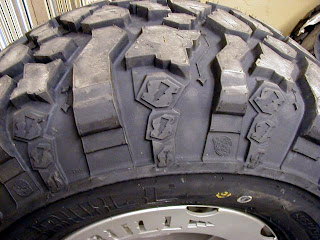TTAB Reverses Ornamental Refusal of Embossed Design on Tire; PTO Fails to Make Prima Facie Case
The Board reversed an "ornamental" refusal to register the design mark shown below for vehicle tires, finding that the PTO Examining Attorney had failed to make a prima facie case that the mark is merely ornamental and does not function as a trademark (Sections 1, 2, and 45 of the Trademark Act). In re Tire Mart, Inc., Serial No. 78292388 (January 22, 2008) [not precedential].

Applicant's specimens (see below) show the lightning bolt design molded into the outside shoulder of the tire and extending onto the sidewall. The groups of three lighting bolts is repeated some 15 to 20 times around the tire. The Board pointed out that the issue of functionality (Section 2(e)(5)) was not raised by the PTO.

The fact that a mark may be "visually pleasing" or ornamental odes not mean it cannot be registered. The question for the Board was "whether applicant's mark is inherently distinctive; in other words, whether - as used on the specimens - the mark is an indication of source notwithstanding any aesthetic qualities it may have."
Recognizing that its conclusion is "somewhat subjective," the Board found that the PTO's evidence and argument does not support the refusal.
The Examining Attorney submitted pictures of other tires with various tread designs to demonstrate that "tire tread consists of many designs that resemble recognized objects." The Board, however, could find no "designs resembl[ing] objects" on the PTO's pictures, and it noted Applicant's argument that its embossed mark is not "tread" in the sense of tire lugs. The specimens showed that the molded design has a "considerably lower profile than the adjacent tread." Moreover, the mark does not appear "where the rubber meets the road."
The Board did agree with the PTO that Applicant's evidence of use of the mark on collateral gods was entitled to little weight, since it did not address the issue of whether consumers would view the lightning bolt design as a source indicator for tires.
On the other hand, the PTO did not provide any evidence that Applicant's design or similarly-placed designs "are widely-viewed as mere ornamentation in the tire industry" (unlike, for example, whitewall on tires). In short, there was essentially no evidence one way or the other as to whether Applicant's design would be perceived as a trademark. Because the PTO had the burden of proof to make at least a prima facie case to support its refusal, the Board reversed.
Text Copyright John L. Welch 2008.




0 Comments:
Post a Comment
<< Home